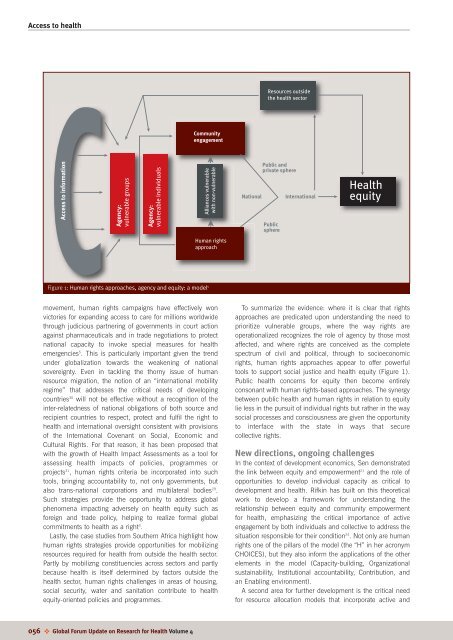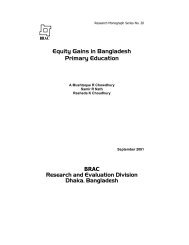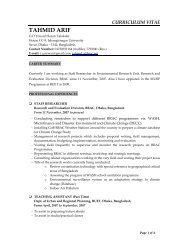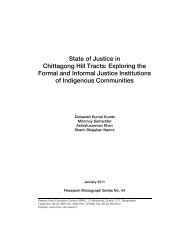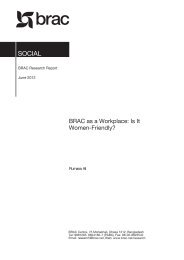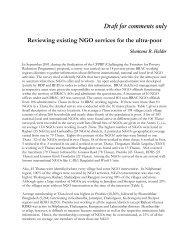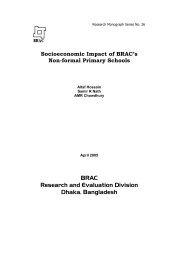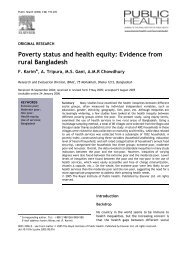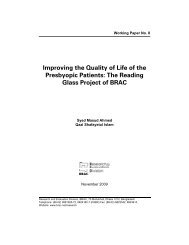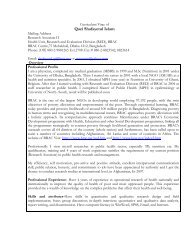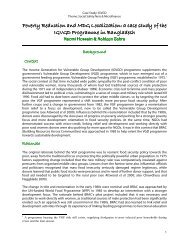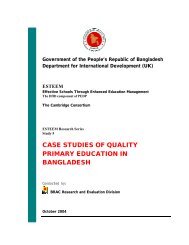Combining health and social protection measures to reach the ultra ...
Combining health and social protection measures to reach the ultra ...
Combining health and social protection measures to reach the ultra ...
You also want an ePaper? Increase the reach of your titles
YUMPU automatically turns print PDFs into web optimized ePapers that Google loves.
Access <strong>to</strong> <strong>health</strong><br />
Resources outside<br />
<strong>the</strong> <strong>health</strong> sec<strong>to</strong>r<br />
Community<br />
engagement<br />
Access <strong>to</strong> information<br />
Agency:<br />
vulnerable groups<br />
Agency:<br />
vulnerable individuals<br />
Alliances vulnerable<br />
with non-vulnerable<br />
National<br />
Public <strong>and</strong><br />
private sphere<br />
Public<br />
sphere<br />
International<br />
Health<br />
equity<br />
Human rights<br />
approach<br />
Figure 1: Human rights approaches, agency <strong>and</strong> equity: a model 5<br />
movement, human rights campaigns have effectively won<br />
vic<strong>to</strong>ries for exp<strong>and</strong>ing access <strong>to</strong> care for millions worldwide<br />
through judicious partnering of governments in court action<br />
against pharmaceuticals <strong>and</strong> in trade negotiations <strong>to</strong> protect<br />
national capacity <strong>to</strong> invoke special <strong>measures</strong> for <strong>health</strong><br />
emergencies 5 . This is particularly important given <strong>the</strong> trend<br />
under globalization <strong>to</strong>wards <strong>the</strong> weakening of national<br />
sovereignty. Even in tackling <strong>the</strong> thorny issue of human<br />
resource migration, <strong>the</strong> notion of an “international mobility<br />
regime” that addresses <strong>the</strong> critical needs of developing<br />
countries 30 will not be effective without a recognition of <strong>the</strong><br />
inter-relatedness of national obligations of both source <strong>and</strong><br />
recipient countries <strong>to</strong> respect, protect <strong>and</strong> fulfil <strong>the</strong> right <strong>to</strong><br />
<strong>health</strong> <strong>and</strong> international oversight consistent with provisions<br />
of <strong>the</strong> International Covenant on Social, Economic <strong>and</strong><br />
Cultural Rights. For that reason, it has been proposed that<br />
with <strong>the</strong> growth of Health Impact Assessments as a <strong>to</strong>ol for<br />
assessing <strong>health</strong> impacts of policies, programmes or<br />
projects 31 , human rights criteria be incorporated in<strong>to</strong> such<br />
<strong>to</strong>ols, bringing accountability <strong>to</strong>, not only governments, but<br />
also trans-national corporations <strong>and</strong> multilateral bodies 29 .<br />
Such strategies provide <strong>the</strong> opportunity <strong>to</strong> address global<br />
phenomena impacting adversely on <strong>health</strong> equity such as<br />
foreign <strong>and</strong> trade policy, helping <strong>to</strong> realize formal global<br />
commitments <strong>to</strong> <strong>health</strong> as a right 3 .<br />
Lastly, <strong>the</strong> case studies from Sou<strong>the</strong>rn Africa highlight how<br />
human rights strategies provide opportunities for mobilizing<br />
resources required for <strong>health</strong> from outside <strong>the</strong> <strong>health</strong> sec<strong>to</strong>r.<br />
Partly by mobilizng constituencies across sec<strong>to</strong>rs <strong>and</strong> partly<br />
because <strong>health</strong> is itself determined by fac<strong>to</strong>rs outside <strong>the</strong><br />
<strong>health</strong> sec<strong>to</strong>r, human rights challenges in areas of housing,<br />
<strong>social</strong> security, water <strong>and</strong> sanitation contribute <strong>to</strong> <strong>health</strong><br />
equity-oriented policies <strong>and</strong> programmes.<br />
To summarize <strong>the</strong> evidence: where it is clear that rights<br />
approaches are predicated upon underst<strong>and</strong>ing <strong>the</strong> need <strong>to</strong><br />
prioritize vulnerable groups, where <strong>the</strong> way rights are<br />
operationalized recognizes <strong>the</strong> role of agency by those most<br />
affected, <strong>and</strong> where rights are conceived as <strong>the</strong> complete<br />
spectrum of civil <strong>and</strong> political, through <strong>to</strong> socioeconomic<br />
rights, human rights approaches appear <strong>to</strong> offer powerful<br />
<strong>to</strong>ols <strong>to</strong> support <strong>social</strong> justice <strong>and</strong> <strong>health</strong> equity (Figure 1).<br />
Public <strong>health</strong> concerns for equity <strong>the</strong>n become entirely<br />
consonant with human rights-based approaches. The synergy<br />
between public <strong>health</strong> <strong>and</strong> human rights in relation <strong>to</strong> equity<br />
lie less in <strong>the</strong> pursuit of individual rights but ra<strong>the</strong>r in <strong>the</strong> way<br />
<strong>social</strong> processes <strong>and</strong> consciousness are given <strong>the</strong> opportunity<br />
<strong>to</strong> interface with <strong>the</strong> state in ways that secure<br />
collective rights.<br />
New directions, ongoing challenges<br />
In <strong>the</strong> context of development economics, Sen demonstrated<br />
<strong>the</strong> link between equity <strong>and</strong> empowerment 21 <strong>and</strong> <strong>the</strong> role of<br />
opportunities <strong>to</strong> develop individual capacity as critical <strong>to</strong><br />
development <strong>and</strong> <strong>health</strong>. Rifkin has built on this <strong>the</strong>oretical<br />
work <strong>to</strong> develop a framework for underst<strong>and</strong>ing <strong>the</strong><br />
relationship between equity <strong>and</strong> community empowerment<br />
for <strong>health</strong>, emphasizing <strong>the</strong> critical importance of active<br />
engagement by both individuals <strong>and</strong> collective <strong>to</strong> address <strong>the</strong><br />
situation responsible for <strong>the</strong>ir condition 24 . Not only are human<br />
rights one of <strong>the</strong> pillars of <strong>the</strong> model (<strong>the</strong> “H” in her acronym<br />
CHOICES), but <strong>the</strong>y also inform <strong>the</strong> applications of <strong>the</strong> o<strong>the</strong>r<br />
elements in <strong>the</strong> model (Capacity-building, Organizational<br />
sustainability, Institutional accountability, Contribution, <strong>and</strong><br />
an Enabling environment).<br />
A second area for fur<strong>the</strong>r development is <strong>the</strong> critical need<br />
for resource allocation models that incorporate active <strong>and</strong><br />
056 ✜ Global Forum Update on Research for Health Volume 4


